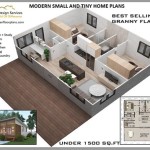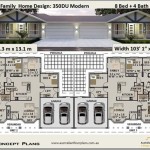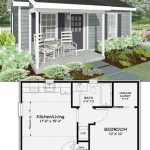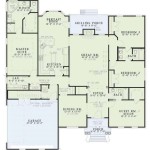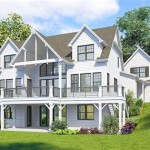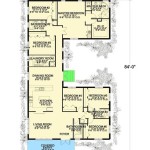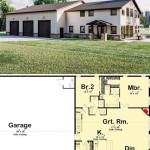Drawing a 2-Bedroom Flat Plan on a Half Plot of Land: Considerations and Best Practices
Developing a functional and aesthetically pleasing 2-bedroom flat plan on a half plot of land requires careful consideration of space optimization, building regulations, and the lifestyle needs of the prospective occupants. A half plot of land, typically understood to be half of a standard building plot in a given locality, presents unique challenges in terms of footprint, setbacks, and overall design. This article will explore key considerations and best practices for drawing a successful 2-bedroom flat plan within these spatial constraints.
Before embarking on the drawing process, it is crucial to ascertain the exact dimensions of the half plot. Plot sizes vary significantly depending on location and local planning regulations. Knowing the precise length and width of the land is fundamental to creating a realistic and compliant design. Additionally, understanding zoning regulations and building codes specific to the area is paramount. These regulations dictate permissible building height, setbacks from property lines (front, side, and rear), floor area ratio (FAR), and other critical parameters that will significantly impact the flat plan.
The initial step involves conducting a site analysis. This encompasses assessing the orientation of the plot with respect to sunlight and prevailing winds. Optimizing the orientation of the building can minimize energy consumption by maximizing natural light and ventilation. Identifying any existing infrastructure, such as utility lines, drainage systems, or mature trees, is also essential. These elements may influence the placement of the building on the plot and require adjustments to the design.
Maximizing Space and Functionality
Given the limited footprint of a half plot, efficient space utilization is paramount. The flat plan should prioritize functionality and minimize wasted space. Open-plan living areas, combining the living room, dining area, and kitchen, are often effective in creating a sense of spaciousness. Strategic placement of windows and doors can further enhance the feeling of openness and improve natural light penetration.
In multi-story designs, the stairwell can consume a significant amount of space. Careful design of the staircase, potentially incorporating storage underneath, is crucial. Consider spiral staircases or compact stair designs to minimize the footprint. Similarly, effective storage solutions, such as built-in closets and shelving units, are essential for maximizing usable space.
The arrangement of the two bedrooms should consider privacy and noise reduction. Positioning bedrooms away from living areas and noisy street-facing sides can enhance the living experience. Ensuring adequate space for comfortable furniture placement and movement within each bedroom is also important. Consider including built-in wardrobes to minimize the need for bulky freestanding furniture.
The kitchen design should prioritize functionality and efficiency. A well-designed kitchen layout, optimized for workflow, can significantly improve the user experience. Consider incorporating space-saving appliances, such as a combination microwave and oven, and maximizing counter space for food preparation. Proper ventilation is also essential to prevent the buildup of odors and moisture.
The bathroom design should focus on maximizing functionality within a compact space. Wall-mounted toilets and sinks can free up floor space and create a more open feel. Consider using a shower instead of a bathtub to save space. Adequate ventilation is crucial to prevent moisture buildup and mold growth.
Compliance with Building Regulations
Compliance with local building regulations is non-negotiable. These regulations are designed to ensure the safety and structural integrity of the building, as well as to protect the environment and the surrounding community. Prior to finalizing the flat plan, it is imperative to consult with local planning authorities to ensure that the design meets all applicable requirements.
Setback requirements dictate the minimum distance that the building must be set back from property lines. These setbacks are designed to ensure adequate light and ventilation for neighboring properties, as well as to prevent encroachment. The setback requirements will vary depending on the zoning regulations of the area.
Floor Area Ratio (FAR) is a ratio between the total floor area of the building and the area of the plot of land. FAR regulations limit the amount of building that can be constructed on a given plot. The FAR will vary depending on the zoning regulations of the area.
Building height regulations limit the maximum height of the building. These regulations are designed to protect views and prevent overshadowing of neighboring properties. The building height regulations will vary depending on the zoning regulations of the area.
Fire safety regulations are designed to protect occupants from fire hazards. These regulations typically include requirements for fire-resistant materials, fire extinguishers, smoke detectors, and emergency exits. Compliance with fire safety regulations is essential for ensuring the safety of the building occupants.
Optimizing for Light, Ventilation, and Privacy
Natural light and ventilation are essential for creating a comfortable and healthy living environment. The flat plan should be designed to maximize natural light penetration and promote natural ventilation. This can be achieved through strategic placement of windows and doors, as well as the use of light-colored materials.
The orientation of the building with respect to sunlight is crucial for maximizing natural light. Orienting the building to maximize exposure to sunlight during the day can reduce the need for artificial lighting and lower energy consumption. Consider using light shelves or reflectors to bounce light deep into the interior of the building.
Natural ventilation can significantly improve indoor air quality and reduce the need for air conditioning. Cross-ventilation, achieved by placing windows on opposite sides of the building, can create a flow of air through the building. Consider using operable windows that can be opened to allow fresh air to circulate.
Privacy is an important consideration in any flat plan. The placement of windows and doors should be carefully considered to minimize views from neighboring properties or public areas. Consider using curtains, blinds, or frosted glass to provide privacy. Landscaping can also be used to create a visual barrier and enhance privacy.
The design of outdoor spaces, such as balconies or patios, should also consider privacy. Screening elements, such as trellises or planting, can be used to create a private outdoor space. Consider the orientation of the outdoor space with respect to the sun and wind to ensure that it is comfortable to use.
In conclusion, drawing a 2-bedroom flat plan on a half plot of land requires a thoughtful and strategic approach. By prioritizing space optimization, complying with building regulations, and optimizing for light, ventilation, and privacy, it is possible to create a functional and aesthetically pleasing living space that meets the needs of the occupants.

Architectural Design Of 2 Bedroom Flat With Decking And Modern Infrastructure Taiwo Salam Co Properties Limited

Low Budget Modern 2 Bedroom House Design In Taiwo Salam Co Properties Limited

2 Units Of Bedroom House Design For A Non Square Land

How Many Bedroooms Can Fit In A Half Plot Of Land Lagos Properties

2 Bedroom Apartment Plan Examples

How Many Bedroooms Can Fit In A Half Plot Of Land Lagos Properties 2

Half Plot House Plan Tiktok

2 Units Of Bedroom House Design For A Non Square Land

Architectural Design Of 2 Bedroom Flat With Decking And Modern Infrastructure Taiwo Salam Co Properties Limited

Typical Floor Plan Of A 3 Bedroom Bungalow In One The Housing Estates Scientific Diagram
Related Posts

